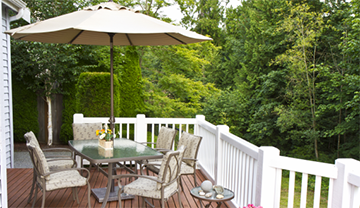4 tips for retiring summer furniture this winter

Even coming out of the hottest summer on record, patio furniture pieces have to come inside sometime. You Move Me has got the skinny on best practices that will help you keep your furniture looking clean and shiny when you take it out next season.
Clean like winter is coming
The most important factor in storing any furniture over a long period of time is proper cleaning and care. Don’t be afraid to give them a good scrubbing before you head to the storage room! Leaving one piece of hamburger between the cushions of your patio chair might yield an entire population of little gribblies. Imagine going down to the basement next spring, throwing off the tarp, and finding that you’ve got a tiny civilization halfway to achieving coal-based power. No doubt you’d rather now!
While hose-water and a clean sponge are solid tools for cleaning wood surfaces (just spray, scrub, rinse, repeat) there are other materials that will require closer attention. Aluminium, vinyl, plastic and similar surfaces should be cleaned with hot, soapy water, before rinsing. For canvas fabrics, use regular upholstery cleaner (it will give them that new car smell!) or a water/bleach mix for larger jobs. Again, a cold rinse afterwards is a great idea.
Finish everything off with some extended time sitting in the sunshine. This will be cheaper and quicker than a blow dryer and trust us – ensure that your pieces are bone dry. When storing furniture, moisture is the enemy.
Know your pieces
As obvious as it sounds, different pieces and materials need different levels of care if they’re going to make it to next summer. Ideally, many items can be stored in the basement or garage, shed, or a dry and enclosed place.
Wrought or cast-iron, and aluminum pieces can be stored under a waterproof tarp, even outside. However beware – pieces like this can still fall prey to the expanding and contracting nature of changing temperature. Tarps that breathe can allow water to evaporate and exit without creating moisture problems in the cracks and joints – and vinyl most often beats plastic. Securing each piece as tightly as possible underneath will minimize the amount of snow that will wind up under the tarp, and will lower the odds that you’ll be chasing after a wind-blown tarp in the middle of December.
Storing wood outside is a no-no. If you must, make sure that your covers are both airtight and watertight. Wicker and rattan should be kept indoors, as should any and all cushions to prevent the growth of mould and mildew. Make sure they’re as dry as possible the entire time. No humidity!
Plastic might seem hardy, but in truth is very susceptible to changes in temperature. It can become brittle, crack or snap if stacked or if it subjected to weight (like say, a few feet of snow) so it’s best stored somewhere dry if it has to sit in the cold.
Staying ahead of the game – year after year
All of this prep will result in fine and fresh looking furniture come next summer, but it’s always best to stay ahead of the game. Protecting your pieces beforehand goes a long way towards increasing their longevity.
That means oiling or varnishing wood, waxing wicker, and painting or sealing metal and plastic furniture. Waxes can also be used for metal pieces, depending on the type, but only after thoroughly brushing it down for any rust that might have accumulated – it’ll only get worse over the winter if you don’t do this beforehand!
The Ian Malcolm effect
Unfortunately, nothing is nature proof, and no matter how many preparations you make. But if you take the time to follow these steps, you will be in good hands come next summer!

